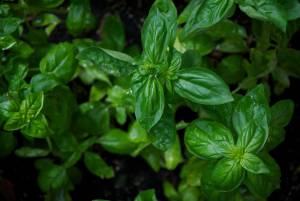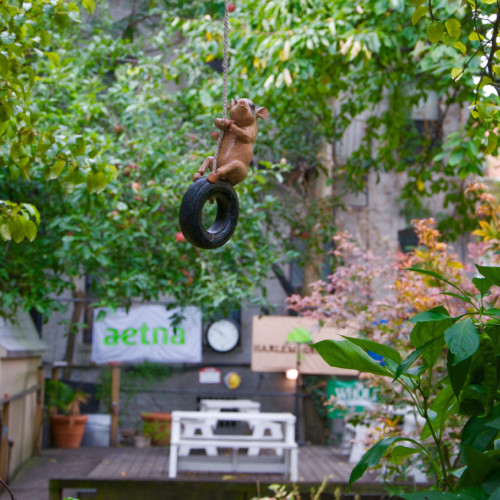
How Harlem Grown Is Changing The Game
In many ways, New York is the quintessential twentieth century city–an industrial matrix of efficiency and economic endeavor. Green spaces exist but they are by and large decorative, functioning as spaces free from obligation and work, as a counterpoint to urban industry. There is a strict division between city and park: one is for work, the other is for play.
And then there is Harlem Grown. Located on 134th between Malcolm X and Adam Clayton Powell Boulevard, Harlem Grown is doing the unthinkable: growing edible food in the middle of Manhattan.
In its first year, Harlem Grown produced forty pounds of food. Last year, it distributed nearly 1,700 pounds to various organizations in the neighborhood. The produce is typically given away to the children who regularly work on the farm, or those in the community that Harlem Grown founder Tony Hillery knows are in need. One building down from the 134th Street farm is the hydroponic greenhouse, which alone fed 150 families the previous year. In addition to their original farm site on 134th (which is open to the public and hosts numerous events including a weekly yoga class) Harlem Grown also operates a larger, production-only farm on 131st. They estimate that their compost program diverted between 8,000 and 9,000 pounds of waste the previous year.
Today, the lot on 134th Street is a far cry from its disreputable state five years ago. Back then, Tony worked with parents at P.S. 175 across the street. On his lunch break one afternoon, he set out to find something healthy to eat. Walking the three blocks around the school, Tony counted fifty-three fried chicken shops and dozens of pharmacies. The juxtaposition spoke for itself: what little food was available was making his community sick.
After asking around, Tony acquired the keys to the lot, which thirty years prior had been an ornamental garden. A few of the original tenants (an apple tree, a pear tree, and a cherry tree) remain in the garden’s current iteration, but everything else on the plot has been built over the course of the last five years. The site is a city-owned GreenThumb garden, which thereby affords it protection in the middle of rapidly-gentrifying Harlem (the greenhouse lot down the street is up for redevelopment, and the lot directly behind the farm is being sold for $3 million).
Since 2011, Harlem Grown has expanded to eight sites, including gardens on roofs and at neighboring schools. The main farm at 134th continues to host visitors–everything from school field trips to corporate volunteer sessions–and on Saturdays they offer free yoga to the community. Their relationships with different schools vary–some schools return weekly, others only have time in their curriculum for one trip. Single educational visits typically include a brief rundown of the garden and a short science lesson on compost, in which kids are encouraged to touch the dirt and learn why not all of it is dirty. (See our images of the compost bin, below.) Ages vary as well (from preschool to graduate students) as anyone who wants to learn is welcome.
There is a certain random element at the heart of what Harlem Grown does. Outside of a few specific crops they purchase, Harlem Grown relies largely on donations for seeds, which leads to a charmingly eccentric farm with familiar staples like chard growing alongside more unconventional types like mallabar spinach (the succulent, heart-shaped leaves in the slideshow below), which makes it the perfect garden for kids. New sites are acquired as they appear–some are purchased, others are made available by generous landlords. The wooden stage in the back hosts everything from meetings to birthday parties to Sukkot celebrations–and of course, the space is always open to people who simply want somewhere peaceful to sit and eat their lunch. Ultimately, the farm exists to serve its community, however it may. As Farm Manager Lydia reiterated on my recent visit to the garden, “We don’t have all the answers, and we don’t pretend to. We do what we can.”
In New York– a city famous for its dazzling pinnacles and international achievements– this is a revolutionary thought.
Yet Harlem Grown is not a quiet, out-there endeavor–their work has attracted the attention of big names. Hanging along the back of the fence are banners from some of their corporate sponsors–Aetna and Whole Foods–alongside more familiar local names like Juice Generation.
These partnerships, however, go beyond a cash transaction. When Juice Generation first approached Harlem Grown, they asked to donate $10,000. Tony politely refused–a risky move for any young nonprofit–emphasizing that a partnership with Harlem Grown must be more than a photo, handshake, and big check. For any real change to be realized, he insisted, there must be a relationship. Corporations must connect with people. Juice Generation came back with a better offer: a monetary donation and the chance for Harlem Grown kids to regularly visit Juice Generation and to attend the opening of their new store. Now, Harlem Grown kids know people in Juice Generation and are familiar with how the company works. The community grows as people connect and learn about future employment opportunities in their neighborhood.
From their hands on, temperate approach to gardening to the ease and integrity with which they approach community engagement, Harlem Grown operates organically; they respond and adapt to the community as is required, and by emphasizing the human element, they are always in touch with what it is people actually need. The nonprofit brings the community together in a kind of live ecosystem, flouting expectations all the while; they change kids who have never touched greens into ones who insist on having a salad with every meal. They are evidence that it is possible to grow produce sustainably in New York City–that not everything needs to be imported from out-of-state. And still: they demonstrate through their programming that hard work outdoors can be fun and engaging for any child or adult of any demographic. New York is a city that must confront its own shortcomings with regard to food and nutrition. Fortunately, with Harlem Grown, the answer is blossoming right around the corner.
To stay apprised of Harlem Grown’s latest happenings, check out their Facebook and Instagram.















































